 W
WThe Kyushu Railway Company, also referred to as JR Kyushu , is one of the seven constituent companies of Japan Railways Group. It operates intercity rail services within Kyushu, Japan and the JR Kyushu Jet Ferry Beetle hydrofoil service across the Tsushima Strait between Fukuoka and Busan, South Korea. It also operates hotels, restaurants, and drugstores across its service region. JR Kyushu's headquarters are in Hakata-ku, Fukuoka.
 W
WThe 103 series is a DC electric multiple unit (EMU) commuter train type introduced in 1963 by Japanese National Railways (JNR), and currently operated by West Japan Railway Company and Kyushu Railway Company. They were also operated by East Japan Railway Company and Central Japan Railway Company.
 W
WThe KiHa 185 series (キハ185系) is a diesel multiple unit (DMU) train type operated by Japanese National Railways in Japan since November 1986, and later operated by Kyushu Railway Company and Shikoku Railway Company
 W
WThe 303 series (303系) is a DC electric multiple unit (EMU) commuter train type operated by Kyushu Railway Company on Chikuhi Line and Fukuoka Subway Kuko Line through-running services in Kyushu, Japan, since 22 January 2000.
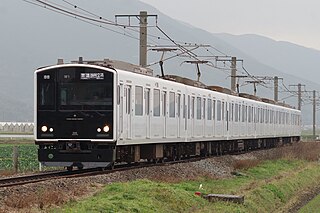 W
WThe 305 series (305系) is a DC electric multiple unit (EMU) commuter train type operated by Kyushu Railway Company on Chikuhi Line and Fukuoka Subway Kuko Line through-running services in Kyushu, Japan, since 5 February 2015. The entire fleet of six six-car sets was scheduled to be in service by the start of the 14 March 2015 timetable revision.
 W
WThe 415 series is a dual-voltage AC/DC outer-suburban electric multiple unit (EMU) train type introduced in 1971 by Japanese National Railways (JNR), and later operated in Japan by East Japan Railway Company, Kyushu Railway Company, and West Japan Railway Company (JR-West).
 W
WThe 455 series is a Japanese dual-voltage electric multiple unit (EMU) train type introduced by Japanese National Railways (JNR) on express services in 1965 and later operated by East Japan Railway Company, West Japan Railway Company (JR-West), and Kyushu Railway Company.
 W
WThe 485 series is a Japanese limited express electric multiple unit (EMU) type introduced in 1964 by Japanese National Railways (JNR), and subsequently operated by the East Japan Railway Company, West Japan Railway Company (JR-West), and Kyushu Railway Company. Approximately 1,500 vehicles were built, although by April 2016, JR East is the only operator still using this type.
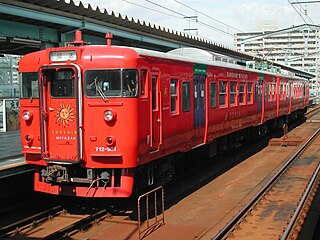 W
WThe 713 series (713系) is a Japanese AC electric multiple unit (EMU) train type first introduced by Japanese National Railways (JNR) in 1984 and later operated on local services by Kyushu Railway Company. As of 1 October 2012, all four of the 2-car sets are still in active service.
 W
WThe 715 series (715系) was an electric multiple unit (EMU) train type introduced in February 1984 by Japanese National Railways (JNR), and later operated by East Japan Railway Company and Kyushu Railway Company on local services in Japan. They were converted from former 581/583 series sleeping car EMUs.
 W
WThe 717 series (717系) was a Japanese AC electric multiple unit (EMU) train type first introduced by Japanese National Railways (JNR) in March 1985 and later operated on local services by the East Japan Railway Company and Kyushu Railway Company. The units were formed by converting former AC/DC dual-voltage 451 series, 453 series, 457 series, and 475 series EMUs.
 W
WThe 783 series (783系) is an AC electric multiple unit train type operated on limited express services by Kyushu Railway Company in Japan since March 1988.
 W
WThe 787 series (787系) is an AC electric multiple unit type operated on limited express services by Kyushu Railway Company in Japan since July 1992.
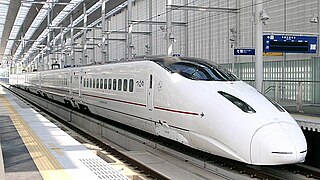 W
WThe 800 series (800系) is a Japanese Shinkansen high-speed train type operated by Kyushu Railway Company on the Kyushu Shinkansen high-speed rail line. Built by Hitachi, the trains were introduced on the Tsubame services from March 2004.
 W
WThe 811 series (811系) is an AC electric multiple unit (EMU) train type operated on local services by Kyushu Railway Company in Japan since 1989.
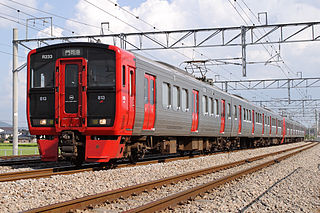 W
WThe 813 series (813系) is an AC electric multiple unit (EMU) train type operated on local services by Kyushu Railway Company in Japan since 1994.
 W
WThe 815 series is an AC electric multiple unit (EMU) train type operated on local services by Kyushu Railway Company in Japan since 1999.
 W
WThe 817 series (817系) is an AC electric multiple unit (EMU) train type operated on commuter and local services by Kyushu Railway Company in Japan since 2001. The design was based on the earlier 815 series, with transverse seating replacing the previous longitudinal seating, although later variants reverted to longitudinal seating.
 W
WThe 821 series (821系) is an AC electric multiple unit (EMU) train type on order by Kyushu Railway Company in Japan. Two three-car trains were delivered in February 2018 for testing in preparation for full production and entry into revenue service.
 W
WThe 883 series (883系) is an AC electric multiple unit (EMU) tilting train type operated on Sonic limited express services by Kyushu Railway Company in Japan since April 1995.
 W
WThe 885 series (885系) is an AC electric multiple unit (EMU) train type operated on limited express services by Kyushu Railway Company in Japan. The type is part of Hitachi's A-train family of multiple units.
 W
WThe A-Train is a seasonal limited express train service operated by Kyushu Railway Company in Kyushu, Japan, since October 2011.
 W
WThe Ariake (有明) was a limited express train service operated in Kyushu, Japan by Kyushu Railway Company. It ran between Hakata in Fukuoka Prefecture and Kumamoto in Kumamoto Prefecture. It operated from 1 October 1950 to 12 March 2021.
 W
WThe Aru Ressha (或る列車) is a two-car deluxe excursion train operated by Kyushu Railway Company in Japan since August 2015.
 W
WThe Aso Boy (あそぼーい!) is a limited express train service in Kyushu, Japan, operated by Kyushu Railway Company since June 2011. The train normally runs between Kumamoto and Miyaji via Aso on the Hōhi Main Line.
 W
WThe BEC819 series (BEC819系), branded "DENCHA", is a two-car battery electric multiple unit (BEMU) train operated by Kyushu Railway Company on inter-running services over the Fukuhoku Yutaka Line and Chikuhō Main Line in Fukuoka Prefecture in northern Kyushu, Japan, since October 2016, and also on the Kashii Line.
 W
WBeetle is a hydrofoil ferry service that travels between Fukuoka, Japan and Busan, South Korea. It is operated by JR Kyushu Jet Ferry, a division of Kyushu Railway Company.
 W
WThe Class DD16 (DD16形) is a four-axle Bo-Bo wheel arrangement diesel-hydraulic locomotive type operated in Japan since 1972. A total of 65 locomotives were built between 1971 and 1975, and as of 1 April 2016, one locomotive remains in service, operated by East Japan Railway Company.
 W
WThe Class DE10 (DE10形) is a class of Japanese C-B wheel arrangement diesel-hydraulic locomotives. 708 locomotives were built between 1966 and 1978. As of 1 April 2016, 138 locomotives remained in operation.
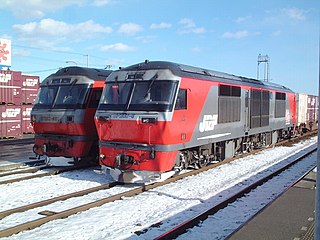 W
WThe Class DF200 (DF200形) is a Bo-Bo-Bo wheel arrangement diesel-electric locomotive type operated by the Japan Freight Railway Company and the Kyushu Railway Company.
 W
WThe Class EF81 is a six-axle Bo-Bo-Bo wheel arrangement multi-voltage AC/DC electric locomotive type operated on passenger and freight services in Japan since 1968. As of 1 April 2016, 44 locomotives remained in service, operated by JR Freight, JR East, and JR West.
 W
WThe Fuji (富士) was a sleeper train that formerly operated between Tokyo and Ōita in Japan. Operated by the Kyushu Railway Company and classified as a limited express service, it was discontinued from the start of the revised timetable on 14 March 2009.
 W
WThe Hayabusa is a high-speed Shinkansen service operated by East Japan Railway Company and Hokkaido Railway Company between Tokyo and Shin-Hakodate-Hokuto in Japan since 26 March 2016. The name was formerly used for a limited express sleeping car service operated by JR Kyushu, which ran from Tokyo to Kumamoto, and was discontinued in March 2009.
 W
WThe Hayato no Kaze is a limited express service in Japan which runs between Kagoshima-Chūō Station and Yoshimatsu Station via the Kagoshima Main Line, Nippō Main Line, and Hisatsu Line. It is operated by Kyushu Railway Company .It will be abolished by the end of 2021.
 W
WThe Huis Ten Bosch is a limited express train service operated by Kyushu Railway Company in Japan. It runs between Hakata Station in Fukuoka, Fukuoka, and Huis Ten Bosch Station, the station for the Huis Ten Bosch theme park in Sasebo, Nagasaki.
 W
WThe Ibusuki no Tamatebako is a limited express service operated by Kyushu Railway Company in Japan since March 2011. It operates between Kagoshima-Chūō Station and Ibusuki Station via the Ibusuki Makurazaki Line.
 W
WThe Class ED76 (ED76形) is a Bo-2-Bo wheel arrangement AC electric locomotive type operated on passenger and freight services in Japan since 1965, originally by Japanese National Railways (JNR), and later by Hokkaido Railway Company, Kyushu Railway Company and Japan Freight Railway Company. As of 1 April 2016, just 10 locomotives remained in service, all operated by JR Freight.
 W
WKamome (かもめ) is a limited express train operated by JR Kyushu in Japan. It operates between Hakata and Nagasaki on the Kagoshima Main Line and the Nagasaki Main Line. Kamome means seagull in Japanese.
 W
WThe Kanmon Railway Tunnel was the first undersea tunnel in Japan. It goes underneath the Kanmon Straits, connecting the islands of Honshu and Kyushu. It is an important link in the Japanese rail network. Its construction began in 1936, and it was completed in November 1942, during the Pacific War. The Honshu-bound tunnel is 3,604 m (11,824 ft) long, the Kyushu-bound tunnel is 3,614 m (11,857 ft). Track gauge is 1.067 m, and its electric power supply is at 1,500 volts DC.
 W
WThe KiHa 35 series (キハ35), along with the similar KiHa 30 and KiHa 36 series, are Japanese diesel multiple unit (DMU) train types formerly operated by the Japanese National Railways (JNR) and JR Group of companies, and later operated by the private railway operators Kanto Railway and Mizushima Rinkai Railway. They were built from 1961 until 1966, and were widely used around Japan. Most units were withdrawn in 2012 with the exception of those used by private railways, which remained in service. Some were later operated by Philippine National Railways on Bicol Commuter Train since 2015, and on Metro South Commuter services since 2017.
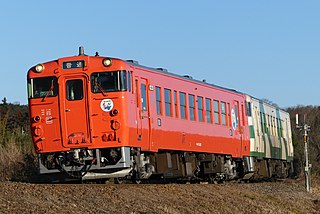 W
WThe KiHa 40 series is a diesel multiple unit (DMU) train type introduced by Japanese National Railways (JNR) in 1977 and operated by all of the Japan Railways Group companies on suburban and rural services in Japan. It also served in other private railway companies in Japan since 2017 following the removal of service which have been pulled out by Japan Railways group and also served in overseas operations in Myanmar since 2011.
 W
WThe KiHa 52 is a Japanese Diesel Multiple Unit (DMU) type formerly operated by Japanese National Railways (JNR), JR Group companies such as JR East, JR West, JR Shikoku & JR Kyushu; and later by the private operator Isumi Railway based in Chiba, Japan, by overseas operators such as Myanmar Railways in Myanmar, and PNR in the Philippines.
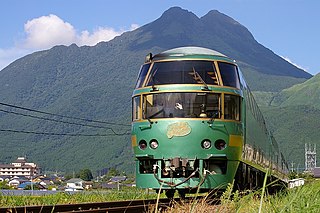 W
WThe KiHa 71 series (キハ71系) is a DMU operated by Kyushu Railway Company exclusively on the Yufuin no Mori service in Kyushu, Japan.
 W
WThe KiHa 183 series (キハ183系) is a diesel multiple unit that has been operated on express services since 1980 under Japan National Railways and later under JR Hokkaido and JR Kyushu. Some variants were eventually built, including some double deck cars and resort trains. Whilst some sets were refurbished and remain in service, some were also withdrawn from service to be scrapped, preserved or be donated to overseas railways.
 W
WThe Mizuho (みずほ) is a limited-stop shinkansen service operated between Shin-Osaka and Kagoshima-Chuo in Japan since 12 March 2011, following the completion of the Kyushu Shinkansen. The name was formerly used for a limited express sleeping car service operated by JNR from 1961, which ran from Tokyo to Kumamoto, and was discontinued in December 1994. The name "mizuho (瑞穂)" literally means "abundant rice" in Japanese and "harvest" in the figurative sense. It was also an ancient name of Japan.
 W
WThe N700 series is a Japanese Shinkansen high-speed train with tilting capability developed jointly by JR Central and JR West for use on the Tokaido and San'yō Shinkansen lines since 2007, and also operated by JR Kyushu on the Kyushu Shinkansen line.
 W
WThe N700S series is a Japanese Shinkansen high-speed train with tilting capability operated by JR Central and JR West on the Tokaido and San'yō Shinkansen lines since 2020, and also planned to be operated by JR Kyushu on the Nagasaki Shinkansen line.
 W
WThe Naha (なは) was a sleeper train service operated in Japan by Kyushu Railway Company, which ran from Kyoto to Kumamoto, passing through Osaka, Okayama, Kokura, and Hakata. It once extended to Nishi-Kagoshima. The journey between Kyoto and Kumamoto was 801.4 km and took approximately 11½ hours.
 W
WThe Nichirin (特急「にちりん」) and Nichirin Sea Gaia (にちりんシーガイア) are limited express train services in Japan operated by JR Kyushu which run from Miyazaki Airport station to Oita and the Sea Gaia service continues to Beppu and Hakata.
 W
WThe Sakura is a high-speed shinkansen service operated between Shin-Osaka and Kagoshima-Chūō in Japan since 12 March 2011.
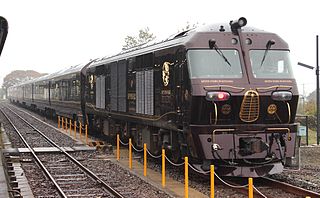 W
WThe Seven Stars in Kyushu is a deluxe sleeping car excursion train operated by Kyushu Railway Company in Japan since October 2013.
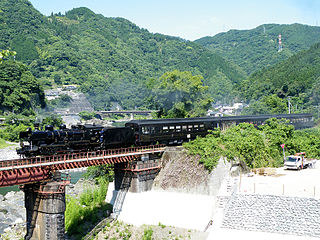 W
WThe SL Hitoyoshi is a steam hauled excursion train operated by the Kyushu Railway Company on the Kagoshima Main Line and the Hisatsu Line since April 2009.
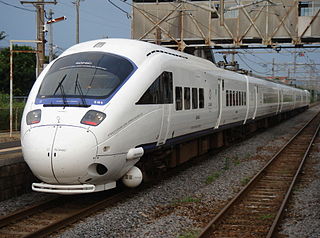 W
WSonic is the name used by Kyushu Railway Company for the limited express train service operating between Hakata and Ōita via Kokura and Beppu along the Kagoshima Main Line and Nippō Main Line in Kyushu, Japan. It runs every 30 minutes at a speed of 130 km/h (80 mph) - with a journey time of approximately 2 hours.
 W
WTORO-Q was a sightseeing open-air train operated by JR Kyushu between Yufuin and Minami-Yufu on the Kyūdai Main Line.
 W
WThe Umisachi Yamasachi (lit. Sea Fortune Mountain Fortune) is a two-car limited express train operated by JR Kyushu in Japan.
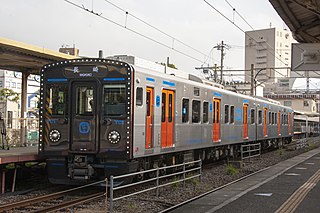 W
WThe YC1 series (YC1系) is a hybrid diesel-electric multiple unit (DMU) train type operated by Kyushu Railway Company in Japan since 14 March 2020. One two-car train was delivered in June 2018 for testing in preparation for full production and entry into revenue service.